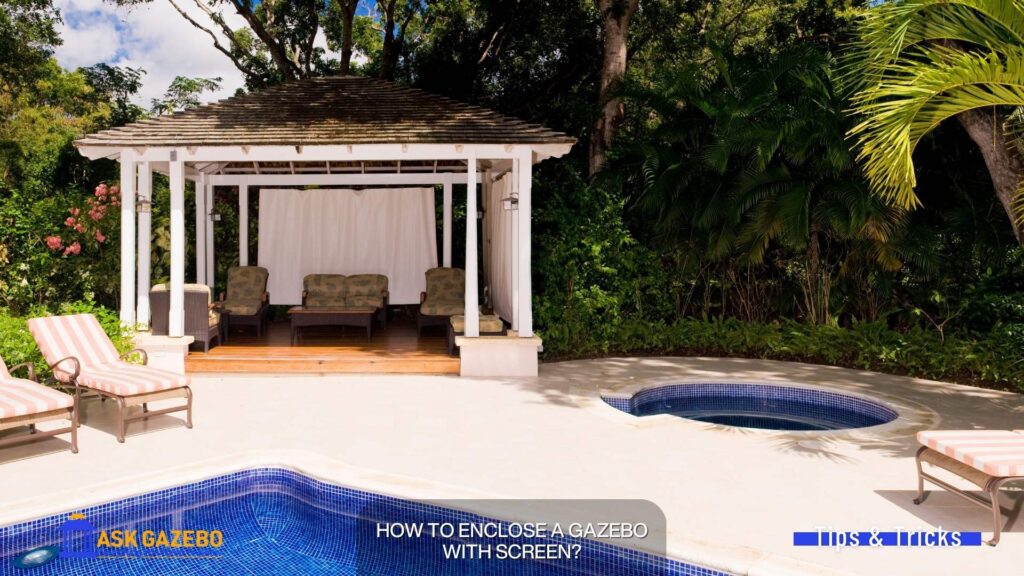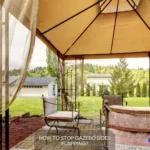People love to use gazebos for outdoor activities like entertaining guests, eating outside, or just spending a relaxing evening outside. Because they mostly come with open sides, they may not keep bugs and pests out.
Because of this, many people choose to put screens around their gazebos.
Putting screens around a gazebo has many benefits.
First and foremost, screens keep bugs out, so you can do things outside without being bothered by them. Screens can also give you more privacy and help you make a quiet spot in your yard. Screens also block some wind, making the gazebo a more pleasant place to be on windy days.
In this article, we’ll show you how to put screens around your gazebo and give you all the information you need to finish this project successfully. So let’s get started!
Materials Needed for Enclosing a Gazebo:
Before building a wall around your gazebo, you should ensure you have everything you need. Here’s a list of what’s most important:
A. Screens:
The most important part of closing up your gazebo is the material you use for the screens. You can choose from screen materials, such as fiberglass, aluminum, and polypropylene.
Fiberglass is a popular choice because it is strong and cheap. Aluminum screens are strong and light, but they can cost more. Polypropylene screens are durable and light, and they are also inexpensive.
So, get the right-sized screen for your gazebo before starting this project.
B. Screen Frame:
The frame of the screen holds the screen material in place. The frame is mostly made of aluminum, which is strong and doesn’t rust or corrode. How big the frame is will depend on your gazebo and how big you want the screens to be.
Take the exact measurements of your gazebo and screen, plan how and where to install the screen, and then decide how big a frame you need.
C. Tools:
To finish the project, you’ll need simple tools like a saw, drill, screwdriver, and measuring tape.
D. Fasteners:
Fasteners hold the screens to the frame and the frame to the gazebo. There are many different kinds of fasteners, such as screws, nails, and clips. Choose fasteners that won’t rust or corrode because they will be out in the weather.
You may also want to buy a screen installation kit in addition to these essential items. These kits usually come with gazebo screens. A screen installation kit is a good option for people who have never done a DIY project.
Once you have all the materials, you can start building your gazebo’s walls. Take your time and measure twice to ensure that everything fits together properly.


How to Enclose a Gazebo With Screen?
Now that you have everything you need, how to cover a gazebo with a screen? Follow these steps to build gazebo walls and to make sure things go well:
A. Figure out how big the gazebo is.
Before you start, make sure you know the exact size of your gazebo.
Note any angles or curves when you measure the gazebo’s height, width, and depth. We will use this information to cut the material for the screen to the right size and put the frame together.
B. Cut the material for the screen to size.
Cut the screen material to size using the measurements you took in step one. For better perfection, you can cut the material for each wall one by one.
While cutting the screen or frame, put extra intention. Carefully measure and cut each piece.
C. Put the screen frame together.
Next, put together the screen frame using the fasteners. First, place the screen in its desired position, place the frame on it, and start fastening it from one side.
Ensure all the screws and bolts are tight to ensure the frame is strong.
After putting together the frame, clip, screw, or nail the screen material to the frame. Make sure the screen material is smooth and has no wrinkles. It will make the screens look neat and professional when the project is done.
You can build a beautiful, useful, screened-in gazebo with patience and attention to detail.
How to Keep Your Screened Gazebo in Good Shape?
Now that you’ve put screens around your gazebo, keeping it in good shape is important to ensure it lasts for years. Here are some ways to keep your gazebo in good shape:
- Screens can get dirty and dusty over time, so you must clean them often to look their best. Clean the screens with mild soap and water, and don’t use harsh chemicals that could damage the material.
- Check the screens for holes or tears every so often and fix any damage as soon as possible. Holes and tears can let bugs and other things into your gazebo, so you should fix them immediately.
- Check the frame every so often for damage like rust or corrosion. If you see any damage, fix it immediately to ensure the frame stays strong and safe.
Doing these simple things ensures your screened-in gazebo stays in great shape for many years.


Subscribe For More Gazebo Videos!
Ask Gazebo
Plexiglass Vs. Screen For Gazebo Enclosure:
Regarding enclosing a gazebo, there are two popular options: screens and plexiglass. Both options have unique pros and cons.
Screens offer a more natural feel and allow maximum ventilation but may not provide privacy and protection from the elements that plexiglass does.
On the other hand, plexiglass provides complete privacy and protection from the elements but may reduce ventilation and is more expensive.
Here are a few pros and cons:
Screen enclosures:
Pros:
- Screens allow for optimal airflow and are ideal for warm weather.
- Screens give the gazebo a natural, open, and airy feel, which can enhance the overall aesthetic of the outdoor space.
- Screens are more budget-friendly than plexiglass, making them a popular choice for many gazebo owners.
Cons:
- Screens do not offer complete privacy, which can be an issue if you’re looking for more privacy in your gazebo.
- Although screens offer excellent ventilation, they allow small debris and insects to enter the gazebo.
- Screens can become damaged over time and require frequent cleaning or replacement.
Allows for maximum ventilation
It provides a natural feel
Cost-effective
Not ideal for privacy
May need maintenance
Plexiglass enclosures:
Pros:
- Plexiglass enclosures offer complete privacy, which is great for those who want a secluded and protected outdoor space.
- Plexiglass protects from the elements, making it ideal for those who want to enjoy their gazebo all year round.
- Unlike screens, plexiglass is much easier to clean and maintain, making it a great option for those who don’t want to spend much time on maintenance.
Cons:
- Plexiglass is more expensive than screens, making it a more expensive option for those on a budget.
- Plexiglass enclosures reduce ventilation, making them less ideal for warm weather.
- Plexiglass is heavier and more difficult to install than screens so it may require additional support and installation efforts.
Provides privacy
Protection from the elements
Easy to clean
More expensive
Decreased ventilation
Harder to install
Screens are the best option if you want a more natural, open, and airy feel. However, plexiglass might be the way to go if you want more privacy and protection from the elements.
Considering Plexiglass? Check How To Enclose A Gazebo With Plexiglass.
FAQs
How do I get the screens to fit on the gazebo’s frame?
Velcro, snaps, hooks, and clips are all common ways to attach screens. Instructions from the manufacturer will tell you exactly how to put the screens on your gazebo.
Can I use screens to close off my gazebo even though it’s not square or rectangular?
Yes, you can put screens around a gazebo, even if it isn’t square or rectangular. To ensure you have enough screen material to cover the gazebo, you will need to measure it carefully and cut the screen material to fit the unique shape of the gazebo.
Can I put screens around my gazebo if I live in a windy place?
Even if you live in a windy place, you can cover a gazebo with screens. But it’s important to ensure the screens are securely attached to the gazebo’s frame, so they don’t get damaged by wind or other weather. You should also protect the gazebo when it’s not being used by putting a weatherproof cover on it.
How can I enclose my gazebo for winter?
To enclose your gazebo for winter, measure the size of your gazebo to determine the amount of material you will need for the enclosure, get the right material (e.g., clear vinyl or heavy-duty plastic panels), install framing, and attach the material with it.
Check out our dedicated guide to learn more about enclosing a gazebo for winter.
Conclusion:
Finally, installing screens around your gazebo can transform it into a private and functional outdoor living space that you can use all year.
Following this article’s steps, you can easily close up your gazebo. It will make it more private and protect you from bugs and bad weather.
A screened gazebo can be the perfect place for a cozy reading nook, a dining area, or just a place to relax and unwind. Enjoy your time.








